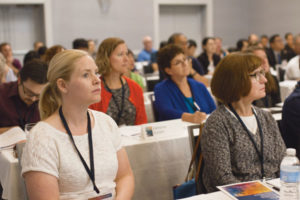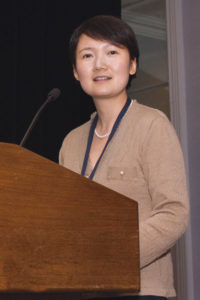Training for the Future
During the 2019 Actuarial Teaching Conference, educators gather to share ideas for preparing leading-edge actuaries
August/September 2019Photographs: Nancy Lambert

The Society of Actuaries (SOA) developed the Actuarial Teaching Conference (ATC) in 2015 to support faculty members from actuarial programs both large and small. As funds for such conferences can be limited for university faculty, it was important to keep the registration fee reasonable and the event location within driving distance of many universities in North America. This summer marked the third North American ATC. The program also was held for the first time in Asia in 2018 with events in Hong Kong and Qingdao, China.
The SOA has long believed research at universities is important for scholarship and the profession. But with many research conferences already in place, there was a need for a conference for faculty members focused on actuarial teaching, methods and efficacy.
2019 Actuarial Teaching Conference
As actuaries’ roles evolve, so does the way they are trained for the future. During the 2019 ATC that took place June 27–28 in Columbus, Ohio, faculty members who teach future actuaries came together to share ideas, learn and network. Presenters focused on a variety of issues including:
- Integrating data science and practice courses to meet professional demands
- Creative ways to teach actuarial science
- Creative-thinking skills for actuarial students

Integrating Data Science and Practice Courses
During the presentation, “Redesigning Actuarial Science Curriculum; Integrating Data Science and Practice Courses to Better Meet Professional Demands,” Vicki Zhang, FSA, ACIA, CERA, MS, associate chair of undergraduate studies in actuarial science at the University of Toronto, explored how educators can arm actuaries with the sophisticated knowledge in statistics and data science that employers require. “One of the key additions to the SOA’s new curriculum is an exam in Statistics for Risk Modeling [SRM], which includes modern statistical and data science techniques,” she explained. “At the University of Toronto, we underwent a major actuarial science curriculum redesign last year in order to stay current with new trends and demand from the profession, and [to be] in line with the SOA’s new curriculum.”
Zhang’s session focused on the data science component of the new curriculum—specifically a sequence of statistical learning and data science courses incorporated into the curriculum, and the various practice-oriented courses offered to improve the balance between theoretical and practice knowledge and skills for students. “The new curriculum enhances actuarial students’ learning experiences by providing pathways that best suit individuals’ academic and professional goals and interests,” Zhang concluded.
Creative Teaching
Because engaged students are better students, Diana Skrzydlo, ASA, continuing lecturer and MActSc director in the department of statistics and actuarial science at the University of Waterloo, during the session, “Creative Teaching in Actuarial Science,” shared tools she employs to make her classes interesting. Skrzydlo discussed how she uses classroom response system (CRS, or also known as clickers) and YouTube videos.
Skrzydlo has used CRS in an introductory probability course since 2015. “I use clickers to engage students, keep track of their skills and collect data to use in class examples,” she explained. She discussed the advantages, drawbacks and best practices for their successful use, and presented survey data about how students perceive clickers and quantitative data about how clickers affect performance on final exams.
When Skrzydlo teaches a Life Contingencies and Stochastic Processes class, she often has a bonus assignment where students can create a YouTube video explaining a course concept in an interesting way. “Many of the videos are really creative and fun,” she noted. “Some of the topics of the videos included Harry Potter petrification insurance, a zombie apocalypse multiple decrement table and a fake movie trailer for A Random Walk to Remember, in which a woman has to gamble to save her boyfriend from the mob.”
Creative-thinking Skills
Stefanos Orfanos, FSA, CERA, Ph.D., assistant professor at DePaul University, discussed the need for creative-thinking skills in an actuarial context during the session, “Creative-thinking Skills for Actuarial Majors.”
“Actuarial exams are demanding, and students spend hundreds of hours poring over past exam questions and memorizing formulas to prepare for them,” Orfanos noted. “It is true that actuaries need to know a wide range of actuarial topics well enough to perform calculations correctly and efficiently. And yet one wonders, ‘Is that the kind of reasoning skills they will be using in their future careers as actuaries?’”
During his presentation, Orfanos showed concrete examples of creative-thinking skills and what they mean in an actuarial context. He also assigned projects from his Loss Models class that required participants to put their creative-thinking skills to use.
The 2019 Actuarial Teaching Conference also included an actuarial employer panel and small group discussions, along with many networking opportunities that allowed attendees to exchange ideas in an informal setting. A full list of the 2019 ATC sessions is available. For more information on university programs, contact Gena Long, director, Professionalism and University Relations, or Tiffany Tatsumi, academic administrator.
Copyright © 2019 by the Society of Actuaries, Chicago, Illinois.

